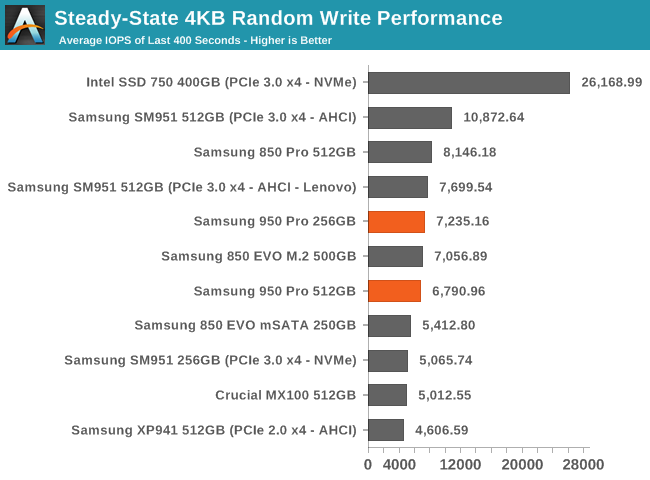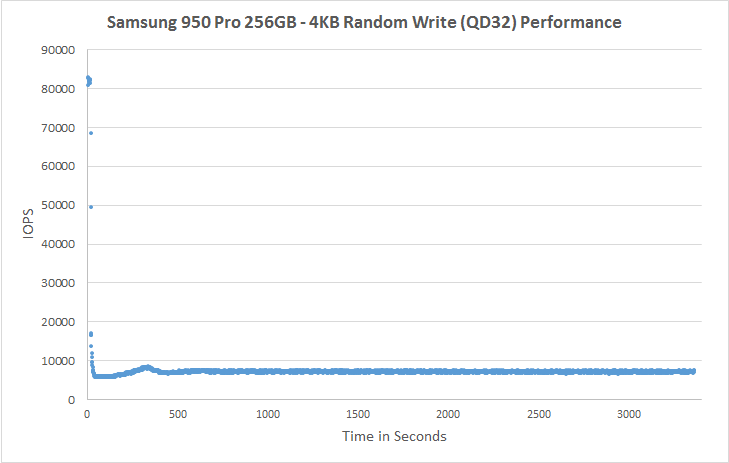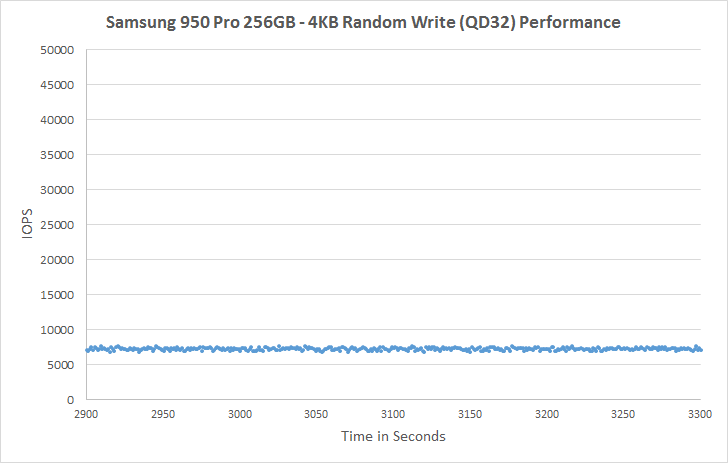The Samsung 950 Pro PCIe SSD Review (256GB and 512GB)
by Billy Tallis on October 22, 2015 10:55 AM ESTPerformance Consistency
Kicking things off, our performance consistency test saturates the drive with 4kB random writes for a full hour, with a queue depth of 32, the maximum supported by the AHCI protocol used by SATA and most PCIe drives. This puts the drive's controller under maximum stress and writes enough data to exhaust all free space and spare area on the drive. This is an unrealistic workload for any client use, but it provides a worst-case scenario for long-term heavy use, and it sheds light on how different SSD controllers behave and if their performance will hold up as they fill up.
The average of the last 400 seconds of the test gives us a steady-state IOPS rating that is usually very different from what the manufacturer specifies for a new, empty drive. We also quantify the consistency of the drive's random write performance, and provide plots of the performance over the course of the test.

Once steady state is reached, performance is determined more by the controller's algorithms than the interface speed, so it's not too surprising to see the 950 Pro performing similarly to other Samsung drives.

The consistency metric shows a surprising disparity between the two 950 Pros, with the 256GB performing much better.
 |
|||||||||
| Default | |||||||||
| 25% Over-Provisioning | |||||||||
Comparing the graphs of the two 950s shows that the inconsistency of the 512GB drive comes from frequent jumps in performance above a solid baseline. This pattern holds even for the test with overprovisioning. Graphing the power consumption over time (not shown) reveals that the periods of lower performance have lower power. If the lower performance were due to periodic background garbage collection, then we would expect power consumption to be at least as high as when the drive is performing well. Instead, it appears that the 512GB drive is experiencing thermal throttling.
 |
|||||||||
| Default | |||||||||
| 25% Over-Provisioning | |||||||||
With most of its time spent thermally limited, our 512GB sample's low average is explained. It appears that the thermal throttling mechanism is bumping the drive down to one of several discrete performance levels, rather than a continuous performance mechanism.










142 Comments
View All Comments
Der2 - Thursday, October 22, 2015 - link
Wow. The 950. A BEAST in the performance SHEETS.ddriver - Thursday, October 22, 2015 - link
Sequential performance is very good, but I wonder how come random access shows to significant improvements.dsumanik - Thursday, October 22, 2015 - link
Your system is only as fast as the slowest component.Honestly, ever since the original x-25 the only performance metric I've found to have a real world impact on system performance (aside from large file transfers) with regards to boot times, games, and applications is the random write speed of a drive.
If a drive has solid sustained random write speed, your system will seem to be much more responsive in most of my usage scenarios.
950 pro kind of failed to impress in this dept as far as I'm concerned. While i am glad to see the technology moving in this direction, I was really looking for a generational leap here with this product, which didn't seem to happen, at least not across the board.
Unfortunately I think i will hold off on any purchases until i see the technology mature another generation or two, but hey if you are a water-cooling company, there is a market opportunity for you here.
Looks like until some further die shrinks happen nvme is going to be HOT.
AnnonymousCoward - Thursday, October 22, 2015 - link
> Your system is only as fast as the slowest component.Uhh no. Each component serves a different purpose.
cdillon - Thursday, October 22, 2015 - link
>> > Your system is only as fast as the slowest component.>Uhh no. Each component serves a different purpose.
Memory, CPU, and I/O resources need to be balanced if you want to reach maximum utilization for a given workload. See "Amdahl's Law". Saying that it's "only as fast as the slowest component" may be a gross over-simplification, but it's not entirely wrong.
xenol - Wednesday, November 4, 2015 - link
It still highly depends on the application. If my workload is purely CPU based, then all I have to do is get the best CPU.I mean, for a jack-of-all-trades computer, sure. But I find that sort of computer silly.
xype - Monday, October 26, 2015 - link
Your response makes no sense.III-V - Thursday, October 22, 2015 - link
I find it odd that random access and IOPS haven't improved. Power consumption has gone up too.I'm excited for PCIe and NVMe going mainstream, but I'm concerned the kinks haven't quite been ironed out yet. Still, at the end of the day, if I were building a computer today with all new parts, this would surely be what I'd put in it. Er, well maybe -- Samsung's reliability hasn't been great as of late.
Solandri - Thursday, October 22, 2015 - link
SSD speed increases come mostly from increased parallelism. You divide up the the 10 MB file into 32 chunks and write them simultaneously, instead of 16 chunks.Random access benchmarks are typically done with the smallest possible chunk (4k) thus eliminating any benefits from parallel processing. The Anandtech benchmarks are a bit deceptive because they average QD=1, 2, 4 (queue depth of 1, 2, and 4 parallel data read/writes). But at least the graphs show the speed at each QD. You can see the 4k random read speed at QD=1 is the same as most SATA SSDs.
It's interesting the 4k random write speeds have improved substantially (30 MB/s read, 70 MB/s write is typical in SATA SSDs). I'd be interested in an in-depth Anandtech feature delving into why reads seem to be stuck at below 50 MB/s, while writes are approaching 200 MB/s. Is there a RAM write-cache on the SSD and the drive is "cheating" by reporting the data as written when it's only been queued in the cache? Whereas reads still have to wait for completion of the measurement of the voltage on the individual NAND cells?
ddriver - Thursday, October 22, 2015 - link
It is likely samsung is holding random access back artificially, so that they don't cannibalize their enterprise market. A simple software change, a rebrand and you can sell the same hardware at much higher profit margins.